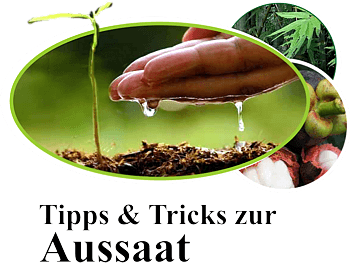Hints and tricks for successful sowing
Hints and tricks
for successful sowing
This is a general approach to successful sowing. Special hints to the sowing of particular seeds will be found with the description of the specific plants.
Preparation of seeds
Usually germination of seeds continues without much help and intervention, however, some of them need special treatment to interrupt dormancy. In the open nature dormancy prevents the sprouting of seeds unless the conditions for the plants are not promising. So, for example, dormancy prevents with so-called „cold-germinators“that the seeds ripening in autumn won’t sprout just some weeks later and so fall victim to the cold winter. They have a kind of protective mechanism that is supposed to allow sprouting not until spring with temperatures growing. Sprouting is controlled by two hormones which are influenced by humidity and temperature. It’s a bio-chemical reaction that allows sprouting not until the shell of the seed is moistened and softened after the rise temperatures after a longer period of cold weather. This is the matter with a lot of our domestic plants paticularly with mountain plants. So such seeds need a special treatment for sprouting ( so-called stratification ). Other seeds, especially those with thick shells, require a mechanical treatment such as sandpapering.
Stratification
Best thing is to let nature run its business by sowing the seeds in the open or in a plant pot on the balcony in late autumn and wait for germination in spring. If the season doesn’t fit in you can use your domestic refrigerator. Just put the seeds into the fridge in a pot with some damp sand.Usually four weeks will do. To prevent drying-up you should cover the pot. After taking the seeds out of the fridge germination will start with temperatures rising. However it may be better if the rise of temperature does not come too abruptly, so you may leave the seeds in the cool cellar for another week.
Scarification
Seeds with thick shells or covered by waxen coats resist the permeation of humidity so that germination will be complicated. With such seeds the shells may be sandpapered or scarified slightly to allow the entry of water, thus reducing the period of germination considerably. However, be careful, you shouldn’t scarify too deeply otherwise the interior of the seed may be destroyed. After scarification you leave the seeds swell in water for 24 hours and then plant it after watering and drying it up.
Tropical and semi-tropical plants:
Tropical and semi-tropical kinds cope well with temperatures between 22-25°C. Temperature often has a considerable impact on the period of germination. Some plants such as Heliconias take higher temperatures. This means the equipment acquisition of a small heated greenhouse in most cases.
Covering the plant pot by a transparent plastic film may help to keep humidity and temperature. However the danger of mildew may then rise drastically and daily ventilation will become absolutely necessary.
Seeds depending on light:
There are seeds that need light for budding. These shouldn’t be covered by earth but should only be strewn on the surface and lightly be pressed against the substrata for contact and to avoid dehydration. These are seeds that mostly are so small and frail that covered by earth they don’t have the necessary strength to break through to the surface. Due to their frailness these seeds should be attended to with greatest care, only be watered from below or by useing an aerosol can. Drying up would kill the seeds in no time so that to avoid evaporation the plant pots should always be covered in the beginning. Daily ventilation is important, too.
Substrate for sowing:
Useing the adequate substrata for successful germination is very important. The frail roots of germ buds are quite damageable and wouldn’t prosper in normal manured potting compost, they would „burn“. In the shops there is a special kind of compost fort he purpose of sowing. For the development of the roots the substrata should be light and permeable so that water as well as oxygen can reach the roots. Therefore the sowing compost should be mixed by one third of sand ( e.g. bird sand from the supermarket ) which avoids clustering of the substrata. If the substrata is too wet it might moulder. The substrata is alright if formed to a bowl in your hand and then pressed there shouldn’t be any water coming through.
Depth for sowing:
There is a rule of thumb: The depth of sowing should be twice the diameter of the grain. Bear in mind that tiny grains should be dealt with like seeds that depend on light.
After sowing:
For successful budding constant humidity and the right temperature fort he particular kind of plant is indispensible. The substrata may not dry up, because damageable seeds then may be killed instantly. This may happen particularly with tiny grains just screwn over the substrata. That’s why the plant pot should be covered by a transparent plastic film to avoid excessive evaporation to provide some kind of greenhouse effect with good air moisture. Watering should happen from below or using an aerosol can to prevent clustering of the substrata. Too little water is as harmful to the plant as too much water, the compost should just be damp, by no means wet. Ventilation now and then prevents mouldering.




